Lancer

Alancerwas a type ofcavalrymanwho fought with alance.Lances were used for mounted warfare in Assyria as early as700 BCand subsequently by India, Egypt, China,Persia,Greece,andRome.[1]The weapon was widely used throughoutEurasiaduring theMiddle Agesand theRenaissancebyheavy cavalry,but fell out of general use by the late 16th century, before its revival bylight cavalryin the early 19th century.
17th-, 18th-, and 19th-century lancers[edit]
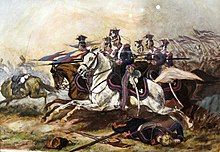
The lancer (Polish:ułan,German:Ulan,French:uhlan) had become a common sight in the majority of European, Ottoman, and Indian cavalry forces during this time, but, with the exception of the Ottoman troops, they increasingly discarded the heavy armour to give greater freedom of movement in combat. The Polish "winged" lancers were amongst the last European units to abandon their armour. There was debate over the value of the lance in mounted combat during the 17th and 18th centuries, with most armies having very few lancer units by the beginning of the 19th century.
However, during theNapoleonic Wars,lancers were to be seen in many of the combatant nations as their value inshock tacticsbecame clear. During the wars, the Poles became a ready source of recruitment for several armies, willingly or unwillingly. Polish lancers served with distinction in the Austrian, Prussian, Russian, and French armies, most famously in Napoleon'sFrench Imperial Guardas the1er Regiment de Chevau-Legers-Lanciers de la Garde Impériale.
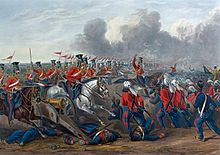
At theBattle of Waterloo,French lances were "nearly 3 metres (9.8 ft) long, weighed around 3 kilograms (6.6 lb), and had a steel point on a wooden staff," according to historianAlessandro Barbero.He adds that they were "terrifyingly efficient." Commander of the French 1st Corps, 4th Division GeneralDurutte,who saw the battle from the high ground in front ofPapelotte,would write later, "I had never before realized the great superiority of the lance over the sword."[2]
Although having substantial impact in thecharge,lancers could be more vulnerable to other cavalry units inclose quarters combat,where the lance proved to be a clumsy and easily deflected weapon when employed againstsabresin a mêlée.[3]By the late 19th century, many cavalry regiments inEurasianarmies were composed of troopers with lances, as primary weapons, in the front rank and horsemen with sabres only in the second: the lances for the initial shock and sabres for the ensuingmêlée.
Lancer equipment[edit]

Lancers typically wore a double-breasted jacket (kurtka) with a coloured panel at the front (plastron), a coloured band of cloth (sash), and a square-topped cap (czapka). Their lance usually had a small swallow-tailed flag (pennon), just below the lance head. The pennons were normally removed or wrapped in a canvas cover during active service. With the improved range and accuracy of infantry muskets and rifles, the high profile presented by lancers with their conspicuous weapons became a problem. Lancers were trained to lower their lances whenscoutingonhilltops,to help avoid detection by enemycombatants.
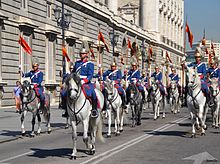
20th-century lancers[edit]


In 1914, lances were still being carried by regiments in theBritish,Indian,French,Prussian,Italian,[4]Chilean,Portuguese,Japanese,Spanish,Ottoman,Belgian,Argentine,andRussianarmies, among others. Almost all German cavalry branches (cuirassiers, hussars, dragoons, and uhlans) retained steel tube lances (stahlrohrlanze) 3.2 meters (10 ft) in length, as their primary weapon.[5]As late as 1914, half of the troopers in each Russian regular cavalry regiment (hussars, uhlans, and dragoons) carried lances on active service, as did allcossacks.[6]
The British cavalry lost the lance for all but ceremonial use in 1903, following theSecond Boer War;but a conservative revaluation led to its reintroduction as an active service weapon from 1909 to 1928.[7][Note 1]
The French army did not have lancer regiments as such, but steel lances 2.97 meters (9.7 ft) in length were carried by the twenty-six dragoon regiments and some light cavalry units in 1914. The French had earlier tested the Indian bamboo lances used by the British cavalry, but had rated them as being too fragile for the shock of encounter.[8]The six Italianlancieriregiments[9]still in existence until 1920 carried the 1870 model of ashwood lance, noted for its balance and manageability.[10]
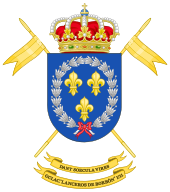
(11th Cavalry Regiment "Spain" )
Prior to the outbreak ofWorld War I,there had been controversy as to whether lances or sabres were the more effectivearmes blanche(i.e. mêlée weapons) for cavalry, but neither proved a match for modernfirearmsand/orartillery.Some armies continued to use lances throughout the war, but they seldom saw use on theWestern Frontafter initial clashes in France and Belgium in 1914. On theEastern Front,mounted cavalry still had a role and lances saw limited use by the Russian, German, and Austrian armies.[11]
During the 1920s and 1930s, the use of lances ceased for active service in most armies. The German cavalry retained the lance as a service weapon until 1927, as did the British cavalry until 1928. Some other armies retained lance-armed cavalry units for ceremonial purposes only. ThePolish cavalrydid not discard the lance as a weapon until 1934[12]or 1937[13]and continued to use it for training and ceremonial purposes until the outbreak ofWorld War II.
Current lancer units[edit]
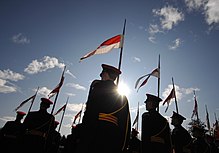

Some modern armored cavalry units are still designated as lancer regiments for historical and ceremonial reasons. There are examples in the armies ofSpain(the King's Lancers Troop of theRoyal Guard's Escort Squadron and the Bourbon's Lancers Group of the 11th Cavalry Regiment),United Kingdom(Royal Lancers),India(2nd Lancers (Gardner's Horse)and20th Lancers),Belgium(1/3rd Lancers Battalion),Portugal(2nd Lancers Regiment),Pakistan,Italy(5th Lancieri di Novara, 6th Lancieri di Aosta, 8th Lancieri di Montebello),Australia(12th/16th Hunter River Lancers,1st/15th Royal New South Wales Lancers),Argentina(2nd Tank Cavalry Regiment "General Paz's Lancers" ),Canada(Lord Strathcona's Horse),Chile(5th Cavalry Regiment "Lancers" ), and the United States (National Lancers, Massachusetts Organized Militia)
Although not classified as lancers, theBrazilian Army'sDragões da Independência(1st Guards Regiment) and the elite soldiers of theColombian National Armyare calledLanceros.
ThePortuguese National Republican Guardhorse squadrons carry lances on mounted parades, as do many cavalry regiments in South America such as Chile, Argentina, Bolivia, and Peru.
The modern ItalianRegiment "Lancieri di Montebello" (8th)parade detachments armed with the lances carried as combat weapons until 1920.
See also[edit]
Notes[edit]
- ^For an illustration of a fully armed lancer, seeMichael Chappell's "Men at Arms Series British Cavalry Equipment 1800–1941" illustration G 1.
References[edit]
- ^Niels M. Saxtorph: "Warriors & Weapons of Early Times"ISBN0-7137-0575-2.
- ^Barbero, pp. 161, 163.
- ^p150, Volume 16, Encyclopædia Britannica, Eleventh Edition
- ^Rodolfo Puletti, page 54, "I Lancieri di Milano 1859–1985", published by Editrice Militare Italiana 1985
- ^John Terraine, page 68, "Mons. Retreat to Victory", 1960,ISBN978-0713411638
- ^Nick Cornish, page 5 "The Russian Army 1914–18,ISBN1-84176-303-9
- ^Alan Larsen & Henry Yallop,The Cavalry Lance,p. 16 and p.56,ISBN978-1-4728-1618-4
- ^Christian Tollet "Les Dragons 1914" Histoire & Collections 2009
- ^Ronald Strom, page 154, "Great Regiments", SBN 297.17647.3, published by Weidenfeld and Nicolson, London 1969
- ^Rodolfo Puletti, pages 54–55, "I Lancieri di Milano 1859–1985", published by Editrice Militare Italiana 1985
- ^Vladimir Littauer, pages 115–116, "Russian Hussar",ISBN1-59048-256-5
- ^Steven J. Zaloga, page 5 "The Polish Army 1939–45"ISBN0-85045-417-4
- ^Alan Larsen & Henry Yallop,The Cavalry Lance,p. 76,ISBN978-1-4728-1618-4
Sources[edit]
- Barbero, Alessandro,The Battle; A New History of Waterloo,Walker & Co., New York 2005,
- Chappell, Mike (2002).Men at Arms Series British Cavalry Equipment 1800–1941.Men–at–arms No. 138 (revised ed.). Oxford: Osprey Publishing.OCLC48783714.
